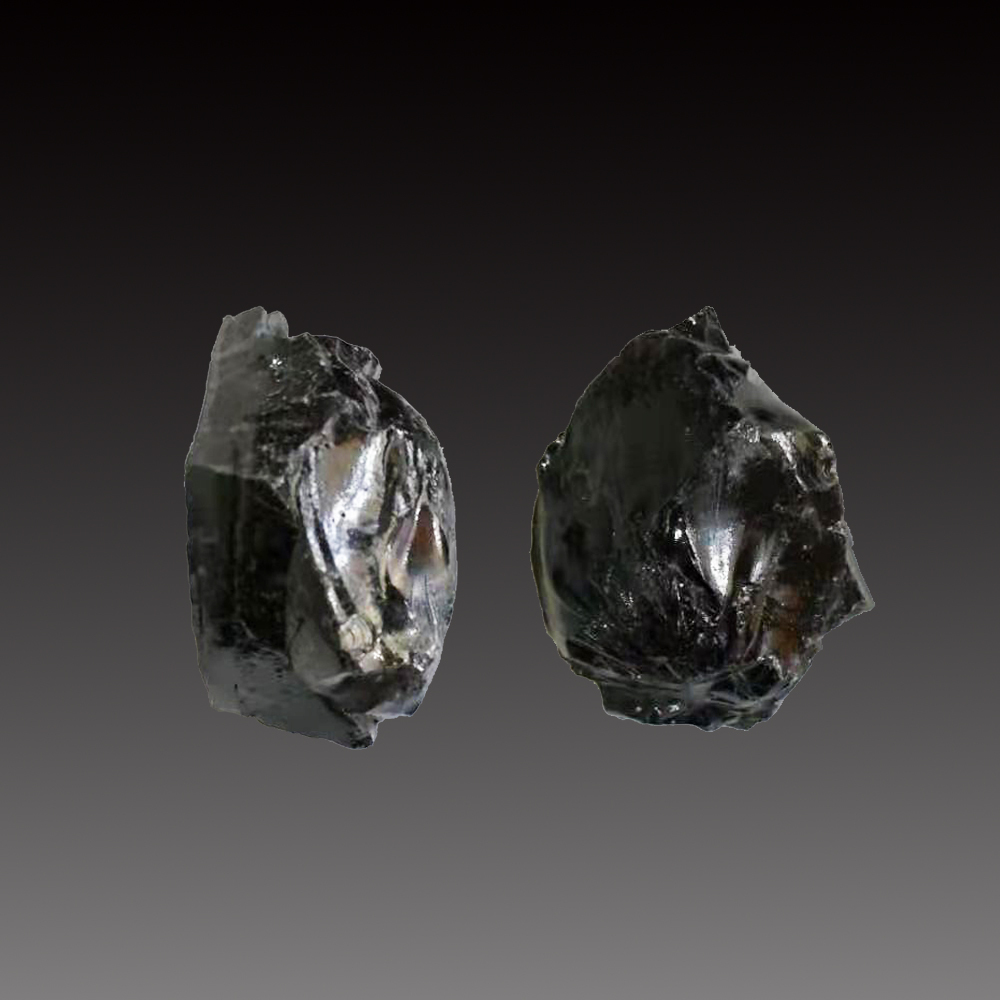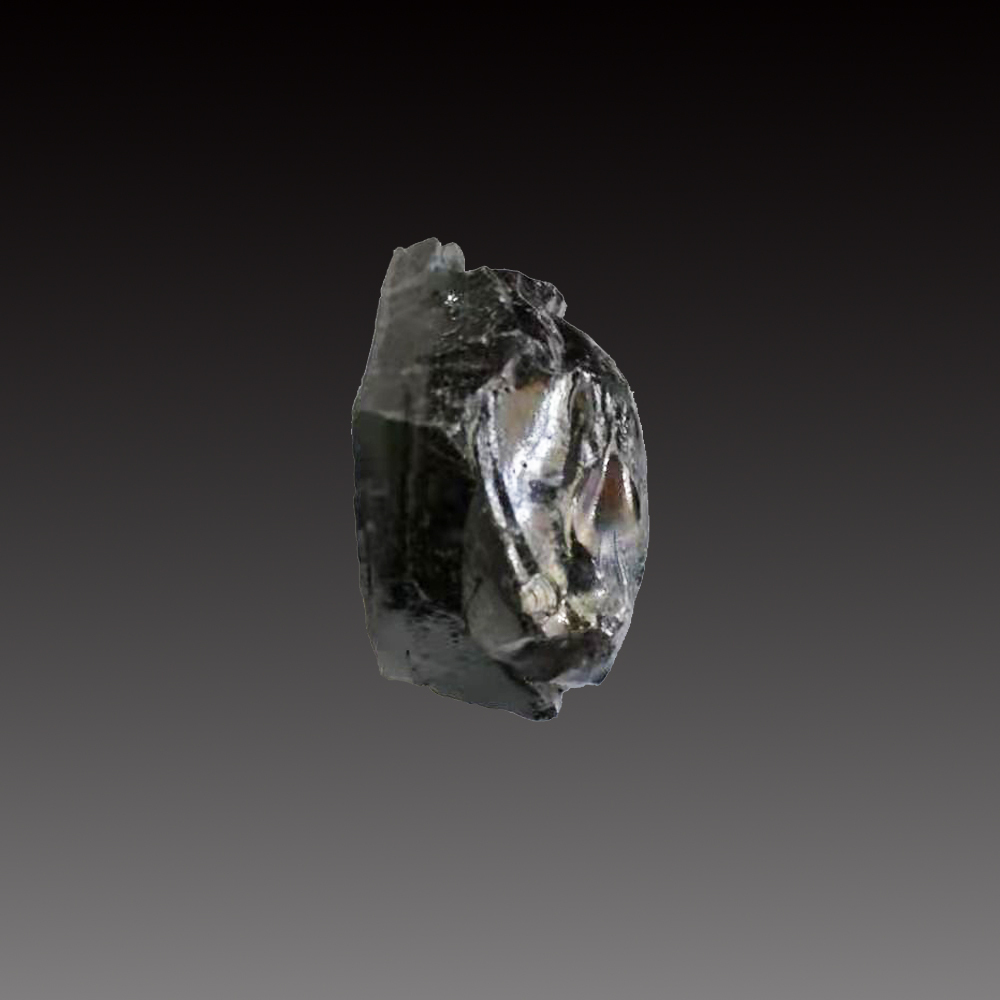玻陨石,全称玻璃陨石。玻璃陨石是地外物体剧烈撞击地球时,地表靶物质熔融后快速凝结的天然玻璃。地表发现的玻璃陨石多呈块状,棕黑色到浅绿色,一般为厘米级大小,表面多具空气动力学熔蚀刻痕。长期的研究证明,玻璃陨石在化学和结构特征上与地球火山玻璃具有明显的区别,不是地质作用的产物。玻璃陨石具有广泛而限定的地理分布,分布在美国南部得克萨斯州和佐治亚州的玻璃陨石称为北美群;分布在中欧捷克、斯洛伐克、奥地利的莫尔达维河流域的玻璃陨石称为莫尔达维石群;分布在象牙海岸的玻璃陨石称为象牙海岸群;最大的一个玻璃陨石群是澳大利亚-东南亚玻璃陨石群,广泛分布于澳大利亚、东南亚半岛及我国的南部地区,分布面积约占地球陆地表面积的10%。由于玻璃陨石在很多特征上与火山玻璃相似,故早期曾被称为黑曜岩。1900年F.E.Suess据其熔融的特征,由希腊语“τηχτοξ”(意谓“熔融”)将之转译命名为英语“Tektite”,并一直沿用至今。本世纪初,由于这种天然玻璃被认为是地外成因的,也曾被称为“Glasys Mete-orite”,“玻璃陨石”这一中文译名即源于此。人类对玻璃陨石的认识可追溯到几万年以前。

从墓葬的发掘与考古中发现,远古时期,人类用玻璃陨石这种天然玻璃作为武器、工具、饰物甚至护身符。近代,在欧洲,珠宝商人曾将之作为宝石而广泛收集。早在10世纪中叶,我国唐朝的刘询在其所著的《岭表录异》中就对“雷公墨”(玻璃陨石的古称)作过描述,这是公认的历史上有关玻璃陨石的最早的文字记载圈。近代的科学文献中,第一篇论述玻璃陨石的文章是由Mayer于1787年完成的。1844年,进化论的创始人Darwin在他的环球旅行中,对纽扣状澳大利亚玻璃陨石进行了考察和科学的描述,并认为它是一种火山玻璃。从18世纪到19世纪末,只有大约40篇论述莫尔达维石(分布在东欧波西米亚和摩拉维亚一带的玻璃陨石)的文章相继发表。本世纪初,对玻璃陨石的研究从一般的描述更多的到了化学组成方面。玻璃陨石真正的科学研究始自本世纪40年代,Barnes对玻璃陨石进行了系统的收集和分类。之后,对玻璃陨石作了散落群的划分、化学成分的分析和成因的讨论。
60年代,由干登月计划的需要,对玻璃陨石和微玻璃陨石进行了最全面、最深入、最详细和最系统的研究,并一直持续到70年代,这期间发表了大量有关玻璃陨石的论文,“Geochimie and Cosmochimie Acta”还分别于1964年和1969年为玻璃陨石研究出版了两期专刊,一系列专著也问世了,对玻璃陨石的认识已达到了相当高的地步。80年代以来,玻璃陨石研究进入综合性研究阶段,主要探讨玻璃陨石的分布范围和形成方式,玻璃陨石事件与其他地质事件的内在关系,尤其是对地球古气候的影响,并试图得出一个统一的成因模式。
Glass meteorite, the full name of glass meteorite. Glass meteorite is a kind of natural glass that quickly condenses after the surface target material melts when the extraterrestrial objects collide with the earth violently. Most of the glass meteorites found on the surface are massive, brownish black to light green, generally centimeter size, with aerodynamic erosion marks on the surface. Long term studies have proved that glass meteorite is different from volcanic glass in chemical and structural characteristics, and it is not the product of geological process. Glassy meteorites have a wide and limited geographical distribution. The glassy meteorites distributed in southern Texas and Georgia of the United States are called the North American group; The glass meteorites distributed in the moldavi River Basin of central Europe, Czech Republic, Slovakia and Austria are called Moldavite group; The glass meteorites distributed in Ivory Coast are called the Ivory Coast group; The largest glass meteorite group is Australia Southeast Asia Glass meteorite group, which is widely distributed in Australia, Southeast Asia Peninsula and southern China, accounting for about 10% of the earth's land surface area. Glass meteorites are similar to volcanic glass in many characteristics, so they were called obsidian in the early stage. In 1900, f.e.suess was written in Greek according to its melting characteristics“ τηχτοξ”( Tektite, which means "melting", has been translated into English and used to this day. At the beginning of this century, because this kind of natural glass was considered to be of extraterrestrial origin, it was also called "glasys mete orite", from which the Chinese translation of "glass meteorite" came. The understanding of glass meteorites can be traced back to tens of thousands of years ago.
From the excavation and Archaeology of tombs, it is found that in ancient times, people used natural glass such as glass meteorite as weapons, tools, ornaments and even amulets. In modern times, in Europe, jewelry merchants had widely collected them as gemstones. As early as the middle of the 10th century, Liu Xun of the Tang Dynasty described "Lei Gong Mo" (the ancient name of glass meteorite) in his book Ling Biao Lu Yi, which is recognized as the earliest written record circle of glass meteorite in history. In modern scientific literature, the first paper on glass meteorites was written by Mayer in 1787. In 1844, Darwin, the founder of the theory of evolution, made an investigation and scientific description of the button shaped Australian Glass meteorite in his journey around the world, and believed that it was a kind of volcanic glass. From the 18th century to the end of the 19th century, only about 40 papers on moldavites (glass meteorites distributed in Bohemia and Moravia in Eastern Europe) were published one after another. At the beginning of this century, the study of glassy meteorites changed from general description to chemical composition. The real scientific research of glass meteorites began in 1940s. Barnes collected and classified glass meteorites systematically. After that, the division of scattered groups, the analysis of chemical composition and the discussion of Genesis are made.
In the 1960s, the most comprehensive, in-depth, detailed and systematic research on glassy meteorites and micro glassy meteorites was carried out to meet the needs of the lunar landing program, and lasted until the 1970s. During this period, a large number of papers on glassy meteorites were published. In 1964 and 1969, geochimie and cosmochimie Acta published two special issues for glassy meteorite research, A series of monographs have been published, and the understanding of glass meteorites has reached a high level. Since the 1980s, the study of glassy meteorites has entered a comprehensive stage, mainly discussing the distribution and formation of glassy meteorites, the internal relationship between glassy meteorites and other geological events, especially the impact on the earth's paleoclimate, and trying to come to a unified genetic model.




